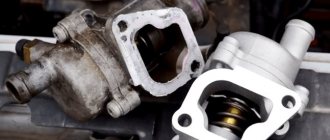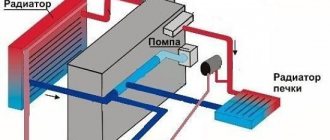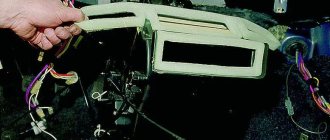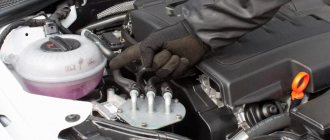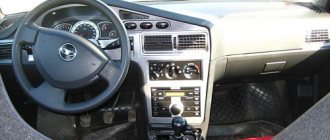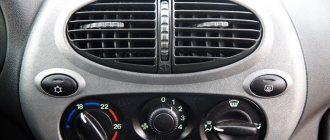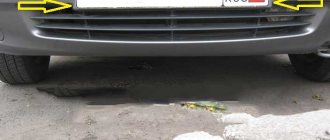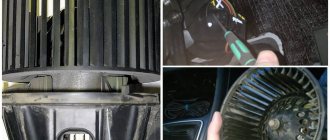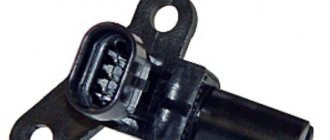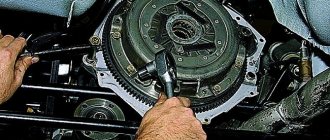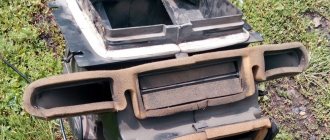How to make the stove on a Gazelle Business heat well
The heater is one of the components of the engine cooling system. It provides an influx of fresh air heated to a predetermined temperature into the car interior, making the trip more comfortable for the driver and passengers. All the charm of its work can be felt during the cold season, when the thermometer drops below zero. But, like any mechanism, it has its own resource, which eventually ends. But it can be extended by carrying out regular preventive maintenance.
How to fix heating problems on stoves in Gazelle
When constructing the old-style Gazelle stove, the manufacturer did not think through the heating design effectively enough. Because of this, it does not heat well, allowing cold air to enter from the outside. The faucet may have poor flow capacity, and even a clogged radiator can quickly lead to problems. These heaters were available on cars produced before the early 2000s, and they require regular cleaning. The simplest thing a driver can do in such a situation is to clean the system and lines.
These manipulations are not always enough to achieve effective heating. In this case, motorists will come to the aid of a small modernization of the system. The easiest option is to replace the aluminum radiator with a copper analogue. Also, many people install an additional new pump under the vacuum booster. In some cases, using foam rubber seals or coating problem areas with sealant helps. It is best to use silicone sealant, which seals the joints well.
However, the design of the new Gazelle stove cannot be called ideal for those who have to travel a lot of time in the winter, and even outside the city. In this case, you can resort to the following sequential algorithm:
- Seal the doorways, dashboard and other potentially problematic areas in the cabin with any insulating material. You can even use sound insulation. As a result, heat will be retained better, and the flow of cold, on the contrary, will be reduced.
- Some people find it helpful to replace the inlet and outlet in the stove itself.
- Alternatively, you can replace the heater. This can improve the efficiency of the entire system.
- In practice, it has been proven that heating can be improved by installing an additional radiator in addition to the standard one. They can be placed under a common cover and connected by tubes into one system.
If a second heater is installed in the system, the antifreeze heats up better, and this will inevitably affect the temperature inside the cabin. Warmth will be better retained in the cabin, which will lead to an increase in the level of comfort when traveling in the Gazelle in the winter.
Operating principle of the heater
A side effect of the engine is heat, which is generated due to fuel combustion and friction of parts. Heat is removed from highly hot parts by the engine cooling system through coolant. It moves along the highways and, having given off heat to the atmosphere, returns back to the internal combustion engine. The coolant movement is provided by a water pump (pump), which operates from the crankshaft pulley via a belt drive. Also, on models with two heaters, an additional electric pump is installed for better coolant circulation throughout the system. To quickly warm up the engine, the system has two circuits (small and large). Between them there is a thermostat, which opens the passage to the large circuit when the coolant reaches the temperature to which it is set. The large circuit has a radiator in its circuit that quickly cools the hot liquid. The heater is included in a small circuit. When operating correctly on a warm engine, the heater blows warm.
The Gazelle Business heater consists of a housing, air ducts with dampers, a radiator, a fan with an impeller, a faucet and a control unit. Hot coolant from the engine enters the stove through the pipes and returns back after heat transfer. For better efficiency, the heater is equipped with an electric motor with an impeller, which blows cold air through the radiator honeycombs and, passing through a heated radiator, the air heats up and enters the cabin already hot. The dampers can be used to direct the flow in the direction we need (on the glass, on the legs, on the face). The temperature is regulated by a tap, which passes a given amount of coolant through the stove. All adjustments are made from the control unit.
Diagnostics
There can be many reasons why the Gazelle Business stove does not work. And for a successful repair, you must first identify the cause of the malfunction, and only then begin to eliminate it:
- The first step is to check the coolant level in the expansion tank. A low coolant level leads to the formation of an air plug in the cooling system, and since the heater is the highest point, the “plug” will be there.
- Next, you need to check the coolant temperature. During the cold season, the engine cools down rapidly before it has time to reach temperature. The temperature sensor may be faulty and show an incorrect temperature value.
- Then you need to check the cabin radiator; it is clogged and may not allow a sufficient amount of coolant to pass through it. You can check this by testing the inlet and outlet pipes; they should be approximately the same temperature. If the inlet pipe is hot and the outlet is cold, then the reason is a clogged radiator.
- If the inlet pipe is also cold, then you need to try the pipe that goes to the radiator from the engine compartment to the tap. If it is hot, then the problem is that the faucet is not working.
- Well, if the pipe to the faucet is cold, then there are more options
- The first thing to check is the thermostat. This can be done with the engine running but not warmed up. We start it and test the surface before and after the thermostat. The surface must be heated before the thermostat, and afterward it must remain cold. If the pipe after the thermostat heats up, then the problem is in the thermostat.
- pump is faulty. It either jammed, or the shaft burst, or the pump impeller became unusable. The fluid does not circulate well through the system, and because of this, the heater may blow cold.
- The gasket between the block and the cylinder head is broken. This malfunction also affects the operation of the heater and the entire engine as a whole. It is accompanied by clouds of white steam from the exhaust pipe and a decrease in coolant in the cooling system. In some cases, antifreeze may be released from the expansion tank.
It's cold in Gazelle business. The stove doesn't heat well. Will replacing the thermostat help?
The Gazelle truck is not just a means of transportation, but a driver’s workplace. And the more comfortable he feels in this place, the further he will be able to travel without experiencing severe fatigue. And if the driver does not get tired while driving, then he makes fewer mistakes and does not endanger himself, the road users around him, or passengers. For commercial vehicles, the issue of comfort should be one of the main priorities, since the driver of such vehicles spends quite a lot of time inside the vehicle. And driving a car with an uncomfortable temperature all day is very difficult. Also, this type of transport is often located outside populated areas, and if any breakdown occurs, it will be very problematic to eliminate the malfunction. Therefore, if you suspect a malfunction of the Gazelle Business stove, you need to carry out detailed diagnostics and make repairs or replacements if necessary.
Gazelle 405 stove blows poorly
View full version: [Big problem] The interior heater is blowing weakly. I had a similar problem, though on 29. I searched for a long time and it turned out the fuse was loose! I adjusted the contacts and everything worked out!
Added after 1 minute 12 seconds, look at the cabin filter!
1. Cabin filter, if it’s not, there’s probably a lot of foliage. 2. The heater radiator is clogged or clogged. 3. Heater motor.
Ps Is the network voltage normal?
Good day to all. I drove around the city all the time so I didn’t notice any problems for short distances, then I drove for 300 km and here it is: Frozen in the car. The stove began to blow very weakly, although that winter everything was fine. And the air ducts themselves are boiling water and there is no air pressure from them, so there is a weak breeze at maximum power. It costs additional electricity. water pump. 406 doors Gas-3110 1998 Tell me what the reason is, could the air ducts be clogged somehow or is it wear on the brushes? Tell me what the reason is, otherwise I don’t want to go back soon and be so cold again.
most likely the heater housing is clogged with leaves and therefore it becomes bad to blow
check the antifreeze level. Is the muzzle closed?
Well, of course there is a muzzle on the muzzle. So even on the highway the fan can work. I try to keep an eye on the antifreeze level; before leaving, I just topped it up to normal. There are no air pockets in the heater radiator since the inlet and outlet pipes to the heater have been swapped and there is an additional cost. email water pump.
who decided to change it? There is a special partition there so that circulation goes throughout the entire radiator, and not just at the beginning between the tubes.
It was just a problem with air locks. so I changed it. But the heating didn’t get any worse.
FreeMood tried changing the polarity of the motor, does it help or not, same problem
Yes, I tried it. If it blows at least a little, then the polarity is correct. Because when you change it, it stops blowing completely.
Off topic, but still: In the summer, well, basically like last winter, the heater motor was blowing weakly, I removed the filter, installed a metal mesh - it became faster, then I changed the motor from a foreign car (I just welded the motor housing to the plate, and removed the groove on the sandpaper, did it in the summer) It seems to have become noticeably better, but I want it to blow evenly both to the right and to the left. In the summer, when the air conditioner is on, this is important (to avoid catching a cold). How to solve this problem?
Well, in order to create uniform air distribution, you need to follow the trial and error method. In general, you need to reduce the cross-section of the tube where the blowing is stronger by narrowing the passage hole. The same amount of air will be supplied by the turbine, and where the muzzle is strong, less air will pass through since the cross-section has become smaller. it will have nowhere to go and will go into another tube and a larger amount of air will be supplied into it. But choosing how much smaller the cross-section of the tube should be should be established experimentally. Well, this is one of the solutions. Maybe we can come up with something easier.
Added after 4 minutes 59 seconds Yes, it’s true, the stove needs to be removed and disassembled, although if you have the desire, potential, and a book with the Kama Sutra, then maybe it’s possible.
It’s just that the radiator of the cooling system and the radiator of the stove are the same. If the radiator of the cooling system is not washed, the car begins to cool down worse over time and sometimes even boils. Basic The radiator is washed at least somewhat when driving when it rains. And the heater radiator has no access to water at all. Yes, and since I have a 98g wolf. It’s not worth talking about the cabin filter at all, then no one could even think about it. So all the dirt goes straight into the radiator.
Added after 5 minutes 51 seconds Tell me, is it possible to remove the heater without removing the dashboard?
I don’t know, maybe off topic, but... . I went to the holidays with a taxi driver, who advised for any car: you put a light bulb, a regular 12V, as an addition to the heater radiator and it gives additional heat (according to him), enough for a T-shirt at -30 outside the window. Now my thought: if you use a cooler (fan) from a PC, it is also 12V, such a disaster can be done for any place in the cabin. I want to do something like this on passengers using an armband (he said
Why the stove on a gazelle does not work
One of the most common and unpleasant breakdowns on GAZelle cars in winter is a malfunction of the stove. There may be several reasons for this problem. The first thing you should check is whether the heating supply or return pipe . In this case, the hot air will not heat the inside of the car, but the street. If such a breakdown is confirmed, the pipe should be put in its place and secured with a clamp. If none of the pipes has flown off, you need to check their temperature .
The return pipe must be cooler than the supply pipe. However, it is quite difficult to determine the temperature difference between two pipes by touching them with your hand. Another reason for faulty heating of a GAZelle may be a clogged stove radiator , which should be removed and properly purged. The radiator can be clogged both externally with various debris that gets into it when the car is moving, and internally with scale, rust, etc. formed. After dismantling the radiator, you need to pay attention to its temperature. If the radiator is cold, it should be repaired or completely replaced.
If the heating radiator is also in good condition, then it is necessary to check the hoses for the presence of delamination , which may not be noticeable during external inspection. The manufacturer recommends replacing all pipes of the GAZelle car every 3 years.
Reasons why the stove on a GAZelle does not heat up
Also quite common reasons for the non-working condition of the stove on GAZelles are:
• insufficient amount of coolant in the radiator (the most common reason, which can be solved by adding antifreeze or antifreeze to the radiator); • air entering the heating system; • leak formation due to leakage of pipes; • malfunction of the faucet on the stove (it is possible to determine that the cause of the breakdown is in the faucet by rotating the temperature control knob in the car interior and observing the reaction of the regulator itself. It is recommended that two people perform this procedure); • pump breakdown; • thermostat malfunction; • breakage of cable ends; • malfunction of the ignition switch; • burnt fuse; • malfunction of the stove blower motor, which can be eliminated by lubricating it; • the damper lever that turns it inside the stove is broken, or rather its very attachment to the rod that turns the damper; • clogging of the air collector; • cracks on the stove body; • missing or incorrectly installed rubber band in the radiator.
Gazelle business stopped blowing hot air only cold
clutch adjustment gazelle business engine 4216
1. there is not enough antifreeze/antifreeze in the radiator. This is the simplest “dumb reason”. This can be solved by adding antifreeze/antifreeze.
2. The heater tap under the hood, which closes/opens the flow of antifreeze through the heater using a cable from the passenger compartment, does not work. Either this cable itself does not make noise. I haven’t seen it in practice, so I won’t offer a solution. Diagnosis is simple - turn the knob of the temperature regulator in the cabin and see what happens to this very regulator. It's easier to do with a partner.
3. The stove radiator is clogged. Moreover, it can be clogged from the outside (i.e. all sorts of flies/poplar fluff/other crap that gets through the intake hole under between the windshield and the hood) or from the inside (rust/all sorts of crap that hucksters and “talented” drivers pour into the radiator) . If your car has a cabin filter, then the outside of the heater radiator will be clean, but it’s the filter that gets clogged and will need to be changed/cleaned. I won’t describe it - search the forum, there is a helpful thread on how to do this. If it’s clogged from the inside, then I did it like this (successfully used on 2 out of 2 brands of 90 bodies from my comrades): take a basin/bucket. pour warm/hot water. dissolve citric acid there as much as you like (it can also help without acid). You also need a pump (for example, a submersible pump from a dacha). remove the inlet and outlet pipes of the stove. Using hoses and clamps of a suitable diameter, you need to assemble a system so that the pump pumps water from the basin into the stove, and the water from the stove drains back into the basin. We turn it on and drive it for as long as we don’t mind. the effect was observed in both my cases. Moreover, in one case, the pump was not able to push water through the radiator in the direct direction at all - the hoses flew off. I had to swing it in the opposite direction - a small pile of derm flew out and everything started to flow. Therefore, it makes sense to swing first in the forward direction and then in the opposite direction. If the hands grow not too far from the head, then there is nothing complicated. There is no need to drain the antifreeze from the system. Of course, when removing the hoses from the stove, a couple of glasses will spill - so then you need to check the level in the radiator.
4. The lever (namely, its attachment to the rod) is broken, which turns the damper inside the stove and directs air through/past the stove radiator. Vamer is right here. This reason was encountered on the other two brands of 90 body from friends and on me personally. Small clarification. The shape of this lever (see attachment) is L-shaped and was attached to the rod with a flimsy bolt. Moreover, it had to be tightened from the engine side - a practically unrealistic task. In one case, the bolt broke off altogether, and in the second, it became loose and the lever began to sag and could not perform its function. Solved the issue by drilling out the old bolt with a long thin drill bit. At the same time, the native carving naturally doesn’t matter. R. was. Next, insert a bolt of suitable length and diameter into the resulting hole, and screw a nut onto it from the engine side. In general, you need dexterous fingers, or better yet, long tweezers.
Bottom line: I did all of the above personally on four different cars. in 2 cases - the radiator is clogged from the inside, in 2 other cases - the lever mount is broken. The effect is guaranteed. All cars are mark2 jzx90.
Practitioners in all services in such cases say that the stove is “aired.” This can be considered a type of reason 3. But IMHO this is generally nonsense, because I myself disassembled the stove to the radiator 8 times and, taking into account the location of the inlet and outlet pipes of the radiator, the stove simply cannot air it - all the air in working order under pressure will fly into radiator!!!
Tees with temperature sensors were cut into the upper pipes
It is more difficult to cut and solder the threaded part for the sensor into the radiator itself. However, the mechanics of our GAZelles installed sensors in the upper radiator pipe (this way there is less fiddling). As a result, the fan turns on earlier than necessary - at a lower temperature. At the same time, the engine warms up somewhat worse, and since it is equipped with electronically controlled fuel injection, errors in the operation of the fuel system may occur - an enriched mixture will be prepared. This will lead to increased fuel consumption. In addition, it is possible that the upper pipe is hot, but there is no fluid circulation through the radiator. But the sensor “will not understand” this - the fan will turn on and work completely pointlessly, in addition, the load on the electrical wiring will increase, and the cyclicity of the relay and sensor contacts will become higher. Correct installation of the sensor in the lower pipe of the UMZ-4216 engine allows you to obtain a more stable temperature regime of the engine.
What to do if the stove on the Gazelle stops heating?
One of the most unpleasant winter breakdowns is the failure of the Gazelle’s standard heating system. All drivers diagnose this breakdown with the amazing ease inherent in the most experienced auto mechanics. This is understandable - it simply becomes a little cold in the cabin. The cars of the Gorky Automobile Plant have always been famous for their maintainability, and modern Gazelles are no exception. Let's see what we can do if such a misfortune happens to our car? First of all, we check the inlet and outlet pipes; most often they are the cause of failure, and the air heated by the engine blows into the engine compartment, instead of blowing into the cabin. This problem can be solved simply by putting the pipes back on and tightening them with clamps. If the original clamp is lost, we go to the nearest construction supply store and buy a new one for 30 rubles.
If it's not too cold outside or if you're in a garage, you can try comparing the temperatures of the two pipes by touch. The output should be slightly colder than the input. If this is the case, let's try to blow out the heater radiator; to do this we will have to remove it. This is not difficult at all, since it is held on by only two bolts. If you remove the radiator from a recently shut down car and it is not hot, most likely this is the cause and you will have to buy a new one. Nowadays, it is most convenient to order spare parts from the GAZ online spare parts store, which works directly with the plant. This is both cheaper and faster than searching small shops for the availability of the required spare part. By the way, the radiator should be purged periodically and simply for preventive purposes.
If everything is fine with the radiator, let's check if the heating system hoses are damaged. If the car is already “aged”, it may be worth replacing them completely. Finally, if all the elements except the heater itself are diagnosed, then the reason is its failure. The new heater can be found there - in the GAZ online spare parts store. We begin the procedure by draining the antifreeze. Then we unscrew the radiator and remove the pipes to clean the area where the radiator is located. Checking the radiator damper. The only unpleasant moment that you may encounter when installing a new heater is a mismatch between the holes in the new heater and in the wall of the engine compartment. In this case, you may have to use a grinder and a drill to make new holes. If the old pipes are sealed, we can put them on the new stove.
The main malfunctions that reduce the efficiency of the Gazelle stove:
Heater Gazelle business troubleshooting.
What to do if something in the heater does not work? Due to the design of the heater, diagnostics in case of failure of its parts is difficult. Initially, as always, you need to check the fuse.
Checking gearmotors.
Checking the gear motors of the windshield blower dampers and deflectors can be checked without completely removing the panels. It is enough to remove its lower part. The main damper motor is accessible from the driver's side. To check gearmotors, you need to disconnect the connector of its electric motor, the connector with a lock, and connect a tester to it in voltmeter mode or a test lamp. With the ignition and heater on, you must press the button that controls this damper. The control lamp should light up. If the lamp is on and the gearmotor does not work, it must be replaced.
If you are on the road and do not have the opportunity to replace the damper drive with window defroster, you can remove the rod from the damper lever on the driver’s side and turn it manually, locking it in the open position. To open the damper on the passenger side, you will need to unscrew the screws securing the gearmotor and, by turning its housing, secure it in the same way.
Checking the electric motor and speed controller.
To check the heater fan motor and the cause of its failure if the fan does not work, you will need to remove the air intake in the engine compartment. Inside the window that opens, two wires with a connector will be visible. To check the power supply, connect a test lamp to the connector terminals and, with the ignition on, turn the heater speed control toward maximum speed. The control lamp should light brightly. When turning the handle towards the minimum speed, the brightness of the lamp should decrease. This indicates that the speed controller is working properly.
If the control lamp is on and the fan does not rotate, then its electric motor is faulty. To check, measure the resistance between the motor terminals in the connector. Motor malfunction may be caused by stuck brushes. In this case, you can try knocking on the heater body. In this case, the operation of the fan can be restored before the next time it is turned off, possibly longer, but you can still get to the service center in a warm place.
201005251656_no_copyright_201004191851_63
— Initially, the design of our engine did not provide for an electric coupling; the fan rotated constantly and was installed on the water pump. The electric coupling for turning on the engine cooling fan was installed at the initiative of GAZ. The GAZ designers did not intend to install an electric fan motor, as is done on most cars, since this required a more powerful generator. After all, the GAZelle minibus version is equipped with additional heaters and lamps. Another advantage of the electric coupling is its quiet operation; partly thanks to it, the GAZelle passed noise tests with a reserve.
Why the stove on a Gazelle may not heat up and what should the driver do?
The domestic auto industry has something to appreciate and something to scold for. Russian-made cars have approximately the same number of advantages and disadvantages.
Among commercial vehicles, the Gazelle occupies a special place. Like any other car, the Gazelle is prone to developing certain malfunctions. But the undeniable advantage is that with such a machine almost all problems can be solved with your own hands.
Before the onset of cold weather, it is especially important to check how the heating system works and whether the driver can get the required amount of heat in the cabin by starting the stove during the frost period. Quite often it happens that the heater does not heat, the heated air does not blow well from the air ducts, or even when the engine is already well warmed up, completely cold outside air enters the cabin.
Main possible malfunctions
To accurately determine why the gazelle stove does not heat or does not work efficiently enough, diagnostic measures should be carried out.
Practice clearly shows that there are several reasons and factors due to which the heater stops blowing or simply does not work at full capacity from time to time.
The most common malfunctions of the heating system on Gazelle cars are associated with:
In order for the heating system to start blowing hot air again and under high pressure, depending on the set regulator on the control panel, appropriate work must be carried out to eliminate the identified faults.
Heater Gazelle business device.
The tap is controlled automatically by the heater control unit depending on the selected temperature. In addition, the temperature of the air supplied to the cabin is regulated by a central damper, which, by turning, directs the air flow, or part of it, through or bypassing the radiator.
In addition to the central damper, there are a number of dampers that redistribute the air flow. The dampers of the Gazelle Business heater, unlike previous models, are controlled by gear motors, not cables. The control is carried out by the heater control unit. The electric heater fan is located inside the housing and to access it it is necessary to remove and disassemble the entire heater. Despite the fact that the fan electric motor is imported, this arrangement completely negates all the advantages of the heater.
The speed of the electric motor is regulated smoothly by turning the handle on the control unit, due to the electronic regulator located on the heater body. To access it, as well as access to almost all elements of the heater, you need to remove the front panel completely. The only thing that can be changed without removing the panel is the heater core. To change it, just remove the glove compartment.
Quick replacement of the engine speed controller for the gazelle business stove
Problem and arrangement for a gazelle business stove
.
The stove does not work on a gazelle business
I found the reason for the failure of the interior heating motor.
Checking the electromagnetic clutch of the car fan BJ1044
When the radiator fan stops spinning, you don’t need to immediately run to the store to buy a new one, you need to determine the cause of the malfunction; perhaps it can be easily eliminated, or perhaps it is not the fan itself that is to blame. How to check the electromagnetic clutch of a BJ1044 car, read the instructions.
When checking the functionality of the fan clutch
When the engine is warm, avoid contact with heated engine parts.
To check the functionality of the coupling, you need to connect the wire to the positive and short it to the wire that comes out of the pump, that is, when the circuit is closed and opened, the electromagnet should click, this will mean that the pump is in working condition.
The same applies to checking the old pump, in this case you need to short the housing to negative and the wire to positive; if nothing clicks, it means that the electric coupling is not working.
Do not check the clutch with the engine running.
The following is a diagram of the activation and control of the electric coupling.
Gray with a black stripe – standard wiring (minus), yellow – power supply to the electric coupling relay
Parameters of the electromagnetic clutch of the ZMZ-405 pump:
Procedure for checking the electromagnetic fan clutch:
Attention: carry out all work under point 4 with the engine stopped!
Diagnostics and repair
The design of the heater is thought out in such a way that in order to check the functionality of any of its parts, not to mention diagnostics, it is necessary to completely remove the entire heater body and disassemble it, having previously dismantled the entire front panel in the cabin.
Without removing the dashboard, only the radiator can be replaced, because it can be accessed through the glove compartment
.
As one of the drivers put it, in order to replace the same faucet damper motor, you need to “pick up a bucket of screws” while removing the front panel.
check the electric damper drive by ear
. When the power is turned on and the temperature setting knob is turned, the sound of the gear motor operating should be heard. In extreme cases, when the gear motor fails on the road and it is necessary to direct air to the windows, it is necessary to remove the rod from the damper and set it to the required position manually.
cold air is blowing from the gazelle stove, fix it in 2 minutes
To watch online, click on the video ⤵
The stove does not heat, Gazelle doors. ZMZ-406 More details
The stove on the GAZELLE does not heat well. Solution! More details
Gazelle, one of the reasons for a cold stove Read more
The Gazelle business stove does not heat. Are looking for! More details
IT'S COLD IN GAZELLE. the secret of a modified stove. More details
5 reasons for the poor performance of the stove on a GAZELLE Read more
Gazelle Cummins heater blows cold air. Gas breakthrough in the cylinder head Read more
Why is it cold in the car? Solution to one of the problems. More details
The stove in the Gazelle doesn't work? what to do? More details
Gazelle stove, why it doesn’t heat, its repair part 2 Read more
The stove does not blow on the gazelle windshield Read more
Gazelle Non-Business, the stove does not work. We are looking for the reason. More details
Gazelle Business - Repair of heater blower dampers Read more
The Gazelle 402 stove does not work Read more
Efficient operation of the stove in cold weather. How to heat the air in the cabin faster. More details
The gazelle stove does not blow on the glass. Repair without removing the panel. More details
Gazelle 405 stove blows poorly
View full version: [Big problem] The interior heater is blowing weakly. I had a similar problem, though on 29. I searched for a long time and it turned out the fuse was loose! I adjusted the contacts and everything worked out!
Added after 1 minute 12 seconds, look at the cabin filter!
1. Cabin filter, if it’s not, there’s probably a lot of foliage. 2. The heater radiator is clogged or clogged. 3. Heater motor.
Ps Is the network voltage normal?
Good day to all. I drove around the city all the time so I didn’t notice any problems for short distances, then I drove for 300 km and here it is: Frozen in the car. The stove began to blow very weakly, although that winter everything was fine. And the air ducts themselves are boiling water and there is no air pressure from them, so there is a weak breeze at maximum power. It costs additional electricity. water pump. 406 doors Gas-3110 1998 Tell me what the reason is, could the air ducts be clogged somehow or is it wear on the brushes? Tell me what the reason is, otherwise I don’t want to go back soon and be so cold again.
most likely the heater housing is clogged with leaves and therefore it becomes bad to blow
check the antifreeze level. Is the muzzle closed?
Well, of course there is a muzzle on the muzzle. So even on the highway the fan can work. I try to keep an eye on the antifreeze level; before leaving, I just topped it up to normal. There are no air pockets in the heater radiator since the inlet and outlet pipes to the heater have been swapped and there is an additional cost. email water pump.
who decided to change it? There is a special partition there so that circulation goes throughout the entire radiator, and not just at the beginning between the tubes.
It was just a problem with air locks. so I changed it. But the heating didn’t get any worse.
FreeMood tried changing the polarity of the motor, does it help or not, same problem
Yes, I tried it. If it blows at least a little, then the polarity is correct. Because when you change it, it stops blowing completely.
Off topic, but still: In the summer, well, basically like last winter, the heater motor was blowing weakly, I removed the filter, installed a metal mesh - it became faster, then I changed the motor from a foreign car (I just welded the motor housing to the plate, and removed the groove on the sandpaper, did it in the summer) It seems to have become noticeably better, but I want it to blow evenly both to the right and to the left. In the summer, when the air conditioner is on, this is important (to avoid catching a cold). How to solve this problem?
Well, in order to create uniform air distribution, you need to follow the trial and error method. In general, you need to reduce the cross-section of the tube where the blowing is stronger by narrowing the passage hole. The same amount of air will be supplied by the turbine, and where the muzzle is strong, less air will pass through since the cross-section has become smaller. it will have nowhere to go and will go into another tube and a larger amount of air will be supplied into it. But choosing how much smaller the cross-section of the tube should be should be established experimentally. Well, this is one of the solutions. Maybe we can come up with something easier.
Added after 4 minutes 59 seconds Yes, it’s true, the stove needs to be removed and disassembled, although if you have the desire, potential, and a book with the Kama Sutra, then maybe it’s possible.
It’s just that the radiator of the cooling system and the radiator of the stove are the same. If the radiator of the cooling system is not washed, the car begins to cool down worse over time and sometimes even boils. Basic The radiator is washed at least somewhat when driving when it rains. And the heater radiator has no access to water at all. Yes, and since I have a 98g wolf. It’s not worth talking about the cabin filter at all, then no one could even think about it. So all the dirt goes straight into the radiator.
Added after 5 minutes 51 seconds Tell me, is it possible to remove the heater without removing the dashboard?
I don’t know, maybe off topic, but... . I went to the holidays with a taxi driver, who advised for any car: you put a light bulb, a regular 12V, as an addition to the heater radiator and it gives additional heat (according to him), enough for a T-shirt at -30 outside the window. Now my thought: if you use a cooler (fan) from a PC, it is also 12V, such a disaster can be done for any place in the cabin. I want to do something like this on passengers using an armband (he said
The carrier replaced the couplings with casings with electric fans
The rest of the assembly should also not be taken lightly. For example, on the GAZ conveyor (in relation to the ZMZ-406 engine), the fan switch sensor is installed in the left radiator tank, where the temperature of the liquid is lower than in the right one, since it has time to cool while passing through the radiator channels, the liquid enters the right tank directly from the engine cooling jacket. It is better and more correct to install a tee with a sensor on the UMZ-4216 in the lower pipe (it is already detachable), at the inlet to the water pump.
Gazelle 405 stove blows poorly
View full version: [Big problem] The interior heater is blowing weakly. I had a similar problem, though on 29. I searched for a long time and it turned out the fuse was loose! I adjusted the contacts and everything worked out!
Added after 1 minute 12 seconds, look at the cabin filter!
1. Cabin filter, if it’s not, there’s probably a lot of foliage. 2. The heater radiator is clogged or clogged. 3. Heater motor.
Ps Is the network voltage normal?
Good day to all. I drove around the city all the time so I didn’t notice any problems for short distances, then I drove for 300 km and here it is: Frozen in the car. The stove began to blow very weakly, although that winter everything was fine. And the air ducts themselves are boiling water and there is no air pressure from them, so there is a weak breeze at maximum power. It costs additional electricity. water pump. 406 doors Gas-3110 1998 Tell me what the reason is, could the air ducts be clogged somehow or is it wear on the brushes? Tell me what the reason is, otherwise I don’t want to go back soon and be so cold again.
most likely the heater housing is clogged with leaves and therefore it becomes bad to blow
check the antifreeze level. Is the muzzle closed?
Well, of course there is a muzzle on the muzzle. So even on the highway the fan can work. I try to keep an eye on the antifreeze level; before leaving, I just topped it up to normal. There are no air pockets in the heater radiator since the inlet and outlet pipes to the heater have been swapped and there is an additional cost. email water pump.
who decided to change it? There is a special partition there so that circulation goes throughout the entire radiator, and not just at the beginning between the tubes.
It was just a problem with air locks. so I changed it. But the heating didn’t get any worse.
FreeMood tried changing the polarity of the motor, does it help or not, same problem
Yes, I tried it. If it blows at least a little, then the polarity is correct. Because when you change it, it stops blowing completely.
Off topic, but still: In the summer, well, basically like last winter, the heater motor was blowing weakly, I removed the filter, installed a metal mesh - it became faster, then I changed the motor from a foreign car (I just welded the motor housing to the plate, and removed the groove on the sandpaper, did it in the summer) It seems to have become noticeably better, but I want it to blow evenly both to the right and to the left. In the summer, when the air conditioner is on, this is important (to avoid catching a cold). How to solve this problem?
Well, in order to create uniform air distribution, you need to follow the trial and error method. In general, you need to reduce the cross-section of the tube where the blowing is stronger by narrowing the passage hole. The same amount of air will be supplied by the turbine, and where the muzzle is strong, less air will pass through since the cross-section has become smaller. it will have nowhere to go and will go into another tube and a larger amount of air will be supplied into it. But choosing how much smaller the cross-section of the tube should be should be established experimentally. Well, this is one of the solutions. Maybe we can come up with something easier.
Added after 4 minutes 59 seconds Yes, it’s true, the stove needs to be removed and disassembled, although if you have the desire, potential, and a book with the Kama Sutra, then maybe it’s possible.
It’s just that the radiator of the cooling system and the radiator of the stove are the same. If the radiator of the cooling system is not washed, the car begins to cool down worse over time and sometimes even boils. Basic The radiator is washed at least somewhat when driving when it rains. And the heater radiator has no access to water at all. Yes, and since I have a 98g wolf. It’s not worth talking about the cabin filter at all, then no one could even think about it. So all the dirt goes straight into the radiator.
Added after 5 minutes 51 seconds Tell me, is it possible to remove the heater without removing the dashboard?
I don’t know, maybe off topic, but... . I went to the holidays with a taxi driver, who advised for any car: you put a light bulb, a regular 12V, as an addition to the heater radiator and it gives additional heat (according to him), enough for a T-shirt at -30 outside the window. Now my thought: if you use a cooler (fan) from a PC, it is also 12V, such a disaster can be done for any place in the cabin. I want to do something like this on passengers using an armband (he said
The stove does not heat, six main reasons. What to do
Today a very relevant article (especially in winter) is that the car’s heater does not heat, or heats very poorly! Why does this happen and what are the main reasons for this? After all, a normal working car should warm up the interior within 10 - 15 minutes (unless, of course, you have a turbocharged engine). If after 15 minutes you have barely warm air (or not at all), and all the glass inside is frozen, then this is not “good”! Read my tips below...
First, let's think about how a car warms up? As we all know, during operation the internal combustion engine heats up very much, this happens from the friction of the pistons against the cylinder walls, as well as from the combustion of the fuel mixture. If you do not cool the engine, it will quickly fail (the pistons will simply jam). A whole cooling system has been made from pipes, pipes and radiators, which prevents the power unit from overheating. So one of the radiators is located inside the cabin, under the instrument panel. Without going into complex technical details, this heater radiator (warmed up by engine coolant) warms up your interior. And in order for the heating efficiency to increase significantly, there is a fan nearby (which has several operating modes, faster slower) that blows on this stove, due to which warm air flows intensively into the cabin (both on the windows and on passengers).
There are about five reasons for poor heating of the stove.
Fan doesn't work
The most common reason is that the fan does not work, the stove does not blow, and, accordingly, warm air does not flow well into the cabin, or rather does not flow at all. Of course, the heater radiator will heat up, but for heating the entire cabin, this is extremely insufficient.
The fan or the electronics that control it need to be replaced. Or look at the fuse, often it simply blows and needs to be replaced .
Insufficient coolant level
This is now unlikely, because many modern cars have antifreeze level sensors. However, such cases do occur (say, in cars of previous generations). Imagine - the antifreeze or antifreeze (maybe due to leaking radiators or pipes), the heater does not receive enough heated liquid, and it is practically cold, the fan is blowing, and the air from the heater is cold (it simply does not heat). You need to add coolant to the level ( read how to do this here ). Also, if radiators or pipes are leaking, then the leak must be eliminated.
It is worth noting that when the coolant leaks, “air plugs” may form, so even if you add antifreeze - antifreeze, you need to wait a while for the air to come out.
Heater radiator is clogged
There may be several reasons:
The first is improper mixing of antifreeze and antifreeze . For example, in G13 you filled in, say, G11 or even antifreeze, then a sediment may appear that will quickly clog all the thin radiator pipes.
Secondly, they poured water. Water not only causes rusting of metals in the system, but also forms scale on the walls.
Third, they eliminated leaks in the heater radiator or main radiator using all kinds of sealants. On the one hand we heal, on the other we cripple. The passages in the radiator of the stove can be clogged with excess of this sealant, the liquid cannot circulate normally in it, and therefore heat it up, which means the stove does not really heat. True, your engine may show high temperatures, at the limit level (the main thing is not to overheat it). You need to either flush the system, clean the heater radiator, or simply replace the radiator.
Engine thermostat faulty
Now about more complex breakdowns. If everything is fine with the stove itself, the fan works, but the stove does not heat well, then the problem may be in the engine thermostat.
The thermostat serves to regulate the so-called “cooling circles” of the engine. When we start the engine, the coolant circulates in a “small circle”; the engine and the interior heater are involved here. Thus, heating of the liquid occurs much faster. After the liquid has warmed up, the thermostat opens a “large circle” and the heated liquid has already flowed to the main engine radiator, which is located under the hood. This is done in order not to overheat the engine if the liquid is overheated.
The only solution is to replace the thermostat! Moreover, the faster, the better; nevertheless, the glass in your cabin will also not thaw, which is fraught in winter, because visibility deteriorates.
Repair
After diagnostics, we begin repairs:
- If the coolant level is below the minimum mark, then it must be brought to normal, having first eliminated fluid leaks, if any. It is possible to remove the plug by pushing the pipes along their entire length with the engine running. Or by placing the front of the car downhill and increasing the engine speed to 3,000 rpm. There is also a way to pump the system with air pressure. You need to remove the upper pipe from the expansion tank and lower it into an empty canister. Next, bring the coolant level to the full tank and, by connecting a hand pump to the vacated fitting, pump air into the tank to the lower mark. Then drain the antifreeze from the canister back into the tank and repeat the procedure. This should be repeated 2 – 3 times.
- If the pipes are barely warm and the sensor shows 90° C, then most likely either it or the temperature gauge itself is faulty. They need to be replaced. In extreme cold (more than -20), you can close part of the radiator (no more than 50%), then the engine will heat up better and cool down more slowly.
- To repair the radiator, it must be removed and washed. If washing does not bring results, then you need to replace it with a new one.
- The faucet may not work due to the drive, or the locking mechanism itself may be faulty. On the Gazelle Business, the faucet turns the electric drive. Therefore, you need to first check the drive, and if it is working, start replacing the faucet. It either does not open completely or is completely stuck in one position, and this can cause a cold air flow.
- To replace the thermostat, you need to drain the coolant, unscrew the cap and replace it with a new one, since this mechanism cannot be repaired.
- The pump also needs to be dismantled and replaced with a new one. This is a very important element, and due to its incorrect operation, the entire engine may fail, since coolant circulation is disrupted and heat cannot be effectively removed from highly heated parts. And, as a result, they overheat and become deformed.
- The worst thing that can happen in a broken gasket is water hammer. When the piston tries to compress the liquid, an increased load is placed on all the internal combustion engine mechanisms, which leads to failure of the entire engine, so such a malfunction must be corrected immediately. In this case, it is prohibited to continue moving using engine power. Such repairs are carried out only with the involvement of specialists, since the cylinder head needs to be grooved; everything else can be done on your own.
There are many reasons why the Gazelle Business stove does not work. But with correct diagnostics and timely repairs, it is possible to fix the problem with your own hands and with a small financial investment.
